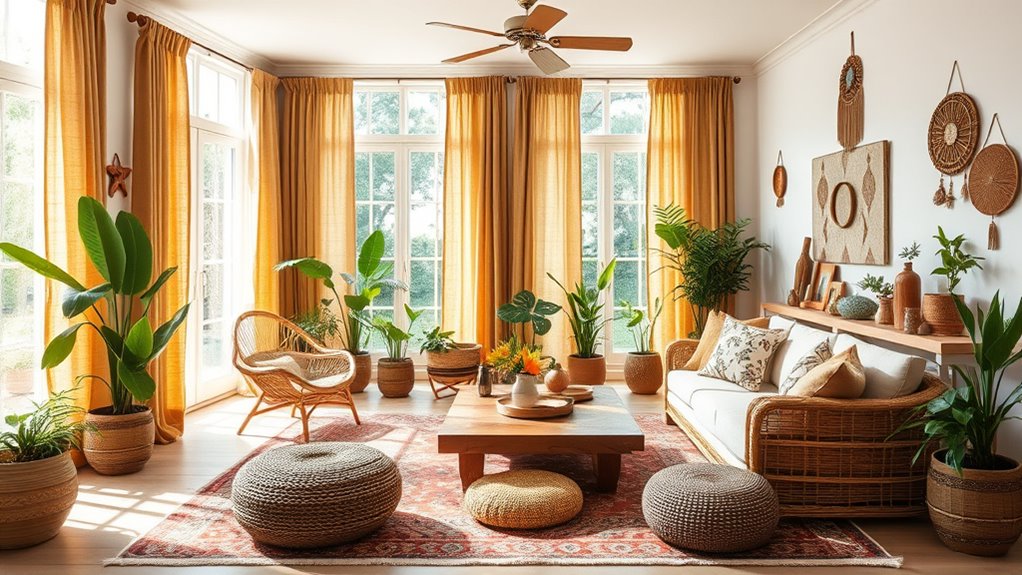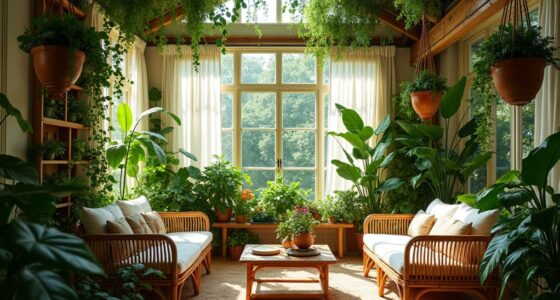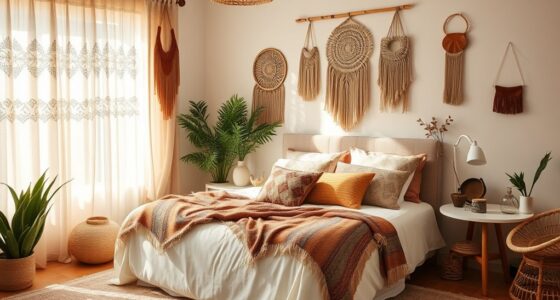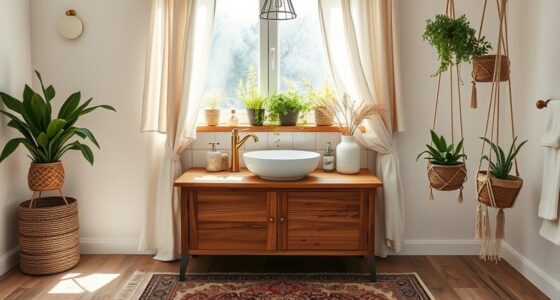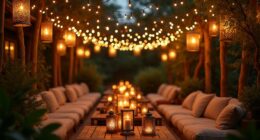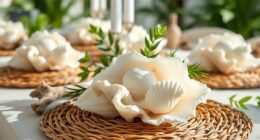To create flow in your open-concept boho space, focus on a cohesive color palette with earthy and jewel tones, and repeat dominant hues across textiles and decor. Arrange furniture to foster open pathways, using layered textures and natural materials to define zones without clutter. Incorporate eclectic art, greenery, and organic accents like woven baskets or rattan furniture to guide movement smoothly. If you continue exploring, you’ll discover how to seamlessly blend style and function for a truly inviting space.
Key Takeaways
- Arrange furniture to promote open pathways and clear sightlines, ensuring smooth navigation throughout the space.
- Use cohesive color palettes and repeating patterns to create visual harmony and flow across zones.
- Incorporate layered textures and natural materials like wood and woven textiles to enhance organic cohesion.
- Define different areas subtly with rugs, textiles, and decor placement without creating rigid boundaries.
- Add greenery and organic accents to guide movement and establish a relaxed, harmonious boho atmosphere.
Emphasizing Cohesive Color Palettes and Patterns

Have you ever wondered how to make an open-concept boho space feel unified and harmonious? The key lies in a cohesive color palette that blends earthy tones like terracotta, olive, and mustard with jewel tones such as emerald green and deep purple. Repeating a dominant hue across textiles, wall art, and accessories creates a smooth visual flow, preventing chaos. Mixing coordinated patterns—like florals and geometrics—within similar color schemes boosts harmony and visual balance. Incorporate subtle variations of your core colors in different textures, such as velvet cushions, woven rugs, and ceramic vases, to add depth. Strategic placement of bold patterns against subdued backgrounds ensures the design feels unified, fostering a seamless, inviting atmosphere throughout your open-concept boho space.
Strategically Arranging Furniture for Seamless Transitions

Creating seamless shifts in an open-concept boho space hinges on strategic furniture arrangement that encourages natural movement and visual harmony. Focus on open flow by carefully planning furniture placement to create clear pathways, allowing easy navigation between zones. Use low-profile and multi-functional pieces to define areas without clutter, maintaining sightlines that keep the space feeling airy. Position seating areas to face each other or a central focal point, fostering conversation and visual cohesion. Incorporate layered textiles and rugs to delineate zones subtly while enhancing texture and warmth. Space planning is key—leave enough room between furniture pieces to prevent congestion. Incorporating rustic lighting can enhance the ambiance and define different zones effectively. Additionally, integrating safe sleep environments can contribute to a nurturing atmosphere, especially in spaces shared with infants. Being mindful of space and organization ensures each zone remains functional and inviting. This thoughtful furniture arrangement guarantees smooth transitions between zones, creating a cohesive, inviting living space that embodies boho charm and functionality.
Incorporating Textural Layers and Natural Elements
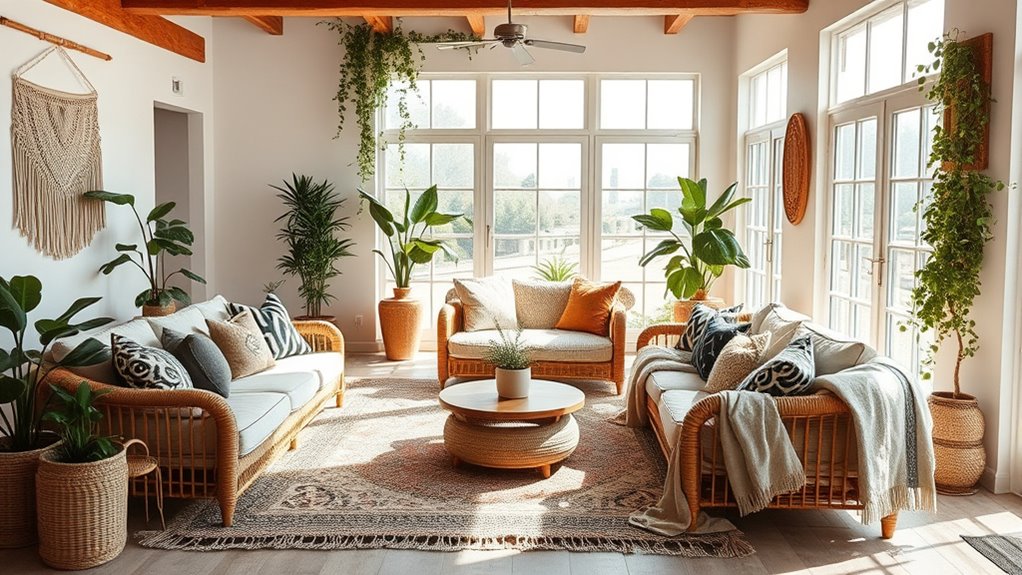
Building on the way furniture arrangement shapes the flow of your boho space, adding layers of texture and natural elements brings warmth and personality to the environment. Incorporate layered textures through woven textiles like rugs, throws, and cushions with diverse patterns and tactile textiles that invite touch. Use natural materials such as wooden furniture, clay pots, and stone accents to enhance the organic, earthy feel characteristic of boho interiors. Tactile accessories like tasseled curtains, beaded wall hangings, and braided baskets enrich the sensory experience, creating visual and physical interest. Combining contrasting textures—smooth ceramics with rough textiles—adds depth and harmony, reflecting boho’s eclectic spirit. These textured decor elements and natural components work together to foster a cozy, inviting atmosphere with seamless flow.
Using Artistic and Eclectic Decor to Define Zones

Ever wondered how to define different zones in an open-concept boho space without sacrificing its free-flowing charm? The key is using artistic and eclectic decor to create visual differentiation. Incorporate statement art and art installations as focal points that naturally guide the eye from one area to another. Use vintage accents and eclectic accessories to add personality and establish zone definition without rigid boundaries. Vary color palettes and textured textiles in each zone to foster a curated vibe while maintaining cohesion. Strategically place rugs and decor elements to subtly delineate spaces, balancing openness with intention. Layer diverse textures and cultural artifacts to enhance the eclectic feel, ensuring each zone feels unique yet seamlessly connected within your bohemian-inspired living space. Incorporating visual differentiation techniques can further enhance the flow and clarity of your layout. Understanding the importance of interior design principles can help you create a cohesive and inviting environment that reflects your personal style. Integrating design principles related to spatial flow can optimize how your space functions and feels.
Enhancing Flow With Greenery and Organic Design Features
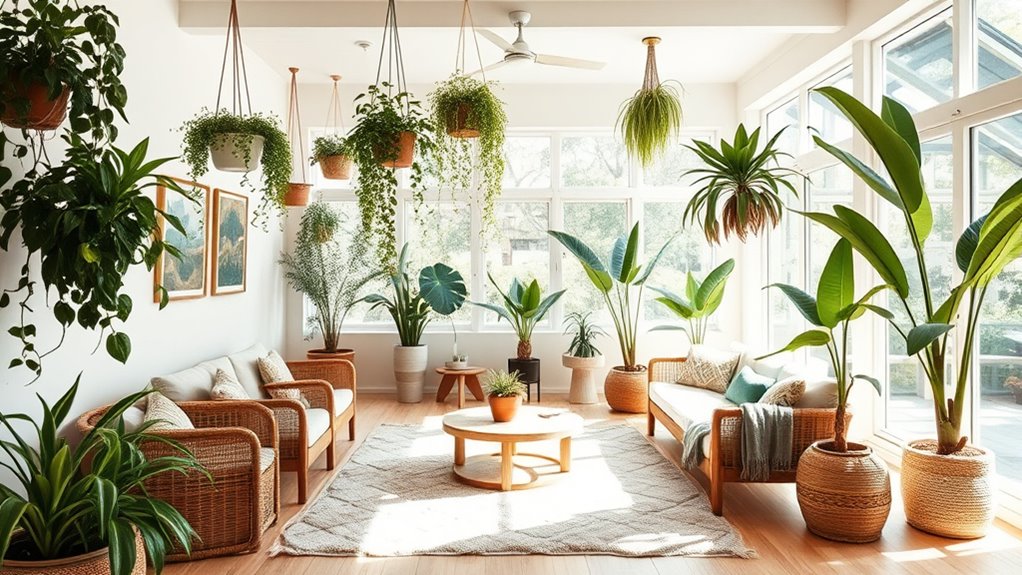
Integrating greenery and organic design features naturally enhances the flow of your open-concept boho space by connecting different zones with visual and tactile cues. You can achieve this through strategic plant placement, layering plants of varying heights and textures, and incorporating organic accents like woven baskets and rattan furniture. These design features create visual harmony and guide the eye smoothly across the room. Using natural materials such as wood and rattan reinforces the organic vibe and complements the greenery. To optimize spatial flow, consider these ideas:
Enhance your open-concept boho space with layered greenery and organic accents for seamless flow and visual harmony.
- Place layered plants near pathways and focal points to direct movement.
- Use organic accents to unify different zones with natural materials.
- Incorporate curved furniture and irregular-shaped rugs to enhance organic design.
Frequently Asked Questions
What Is the Difference Between Boho and Bohemian Style?
You might wonder about the difference between boho and bohemian style. Boho is a more modern, polished take on traditional bohemian design, blending vintage, artisanal pieces with current trends for a sleek look. Bohemian style, on the other hand, is more eclectic, layered, and free-spirited, reflecting artistic and nonconformist roots. While both draw from the same inspiration, boho is more accessible and streamlined, fitting contemporary interiors better.
What Is the Key to Creating a Bohemian or Boho Look?
The key to creating a boho look is blending diverse textures, patterns, and colors to achieve an eclectic yet harmonious vibe. Use natural materials like rattan and woven textiles, layering rugs, throws, and curtains for depth. Incorporate global-inspired decor and handcrafted accessories to add cultural richness. Keep the layout casual and unstructured with open sightlines and thoughtfully arranged furniture to foster that free-spirited, relaxed atmosphere characteristic of boho interiors.
How to Make Your Living Room Bohemian?
You want your living room to feel bohemian, right? Start by layering vibrant textiles like rugs, throws, and cushions with earthy tones and bold patterns. Incorporate furniture with curved shapes and low seating to encourage relaxed conversations. Keep the space open by removing unnecessary partitions, and add diverse textures like wicker or rattan. Finish with lush indoor plants to connect with nature and soften the overall look.
What Are the Rules of the Bohemian Style?
You should know that bohemian style rules are all about embracing individuality and creativity. You don’t need perfect symmetry or matching pieces; instead, you layer textures, colors, and patterns freely. Use natural materials like wood and linen, and incorporate vintage or global accents. Most importantly, celebrate imperfection and a relaxed vibe, creating a space that feels personal, warm, and effortlessly eclectic. Let your personality shine through every element.
Conclusion
By thoughtfully blending colors, patterns, and natural elements, you create a living space that flows like a gentle stream. Your furniture arrangements and eclectic decor act as guiding currents, leading the eye smoothly from one zone to the next. With greenery and organic touches, your boho space feels as inviting as a sun-dappled garden. Embrace these details, and watch your home become a harmonious sanctuary that effortlessly breathes with your unique style.
